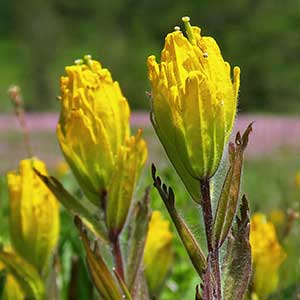Castilleja occidentalis
Castilleja levisecta
western Indian paintbrush, western or western yellow paintbrush, western paintbrush
golden Indian paintbrush, golden paintbrush
several to many, erect or ascending, usually short-decumbent at base, unbranched, sometimes glabrous proximally, hairs spreading, long, soft, mixed with medium length to short stipitate-glandular ones only in inflorescence.
few to many, erect, ± decumbent or creeping at base, unbranched, sometimes branched, hairs spreading, medium length and long, soft, mixed with short stipitate-glandular ones.
green to deep purple, linear-lanceolate to broadly lanceolate (to linear on sterile shoots), 1.5–4(–5.5) cm, not fleshy, margins plane, flat, prominently veined, 0–3(–5)-lobed, apex acute to rounded;
lobes ascending, lanceolate, apex acute.
green to purple or brown-tinged, linear-lanceolate proximally, oblong-ovate or -obovate distally, 0.8–5.2 cm, not fleshy, margins plane, distalmost sometimes ± wavy, involute, 3–7(–11)-lobed, apex obtuse;
lobes erect to ascending, linear to linear-spatulate, very short, toothlike, usually arising from distal 1/3 of blade, apex rounded.
2–7(–10) × 1–3.5 cm;
bracts greenish to pale greenish yellow throughout, often aging dull reddish brown or reddish purple proximally, rarely dull reddish brown throughout, or proximally green, dull reddish brown, or reddish purple, distally greenish white, yellow, or cream, broadly lanceolate to widely oblong to ovate, 0–3(–7)-lobed;
lobes ascending, triangular to lanceolate, medium length, usually arising at or above mid length, rarely just below, central lobe apex obtuse to rounded, others acute.
2.5–25 × 1–4 cm;
bracts bright yellow throughout, or proximally greenish, distally bright yellow, sometimes deep yellow-orange, especially with age, oblong, elliptic, or obtuse to ovate, (0–)5–9(–13)-lobed, sometimes wavy-margined;
lobes erect to ascending, oblong, short to medium length, arising above mid length, central lobe apex rounded, lateral ones rounded to acute.
straight, 16–25 mm;
tube 9–15 mm;
teeth and part of abaxial lip sometimes exserted, beak exserted;
beak adaxially green, (2.5–)5–9 mm;
abaxial lip green, reduced, often visible through abaxial cleft, slightly pouched, 1.5–3 mm, 25–50% as long as beak;
teeth incurved to ascending, white, sometimes green, 0.7–2 mm.
straight or slightly curved, 17–28 mm;
tube 12–15 mm;
beak exserted, adaxially green or greenish yellow, 6–8 mm;
abaxial lip yellow or greenish, reduced, not inflated, 2–3 mm, 25–33(–50)% as long as beak;
teeth ascending to erect, yellow, 0.5–1.5 mm.
proximally green to purple, distally colored as bracts, 12–20 mm;
abaxial and adaxial clefts 5–9(–10) mm, 40–50% of calyx length, deeper than laterals, lateral 1–3(–4.5) mm, 5–20% of calyx length;
lobes lanceolate to triangular, apex acute, obtuse, or rounded.
distally yellow, 13–22 mm;
abaxial and adaxial clefts 4–9.5 mm, 30–40% of calyx length, deeper than laterals, lateral 2.5–4.5 mm, ca. 25% of calyx length;
lobes linear to narrowly oblong or narrowly lanceolate, apex obtuse, sometimes rounded to acute.
= 24, 48.
= 24.
Castilleja occidentalis
Castilleja levisecta
Castilleja occidentalis has a wide distribution in the southern Rocky Mountains, a gap in its distribution in Wyoming, and reappears in Montana and the Canadian Rockies. Bract lobing and color vary considerably but without correlation to geography. Although C. occidentalis resembles an alpine form of C. septentrionalis, C. occidentalis is missing in several regions in the distribution of the latter, even when extensive areas of suitable habitat are available, and has a discrete range.
(Discussion copyrighted by Flora of North America; reprinted with permission.)
Castilleja levisecta is listed as threatened in the United States and endangered in Canada, where it is extremely rare. Most of its grassland habitat has been altered by development in the Puget Trough, and there are historical stations in the metro areas of what are now Victoria, Portland, and Seattle. For several decades, C. levisecta was considered extirpated from Oregon. However, recent reintroduction programs in Oregon and Washington have been very successful at reestablishing this species at several sites in the Willamette Valley. The bright yellow inflorescences often gradually age to a golden yellow color, unique in the genus.
Castilleja levisecta is in the Center for Plant Conservation’s National Collection of Endangered Plants.
(Discussion copyrighted by Flora of North America; reprinted with permission.)


